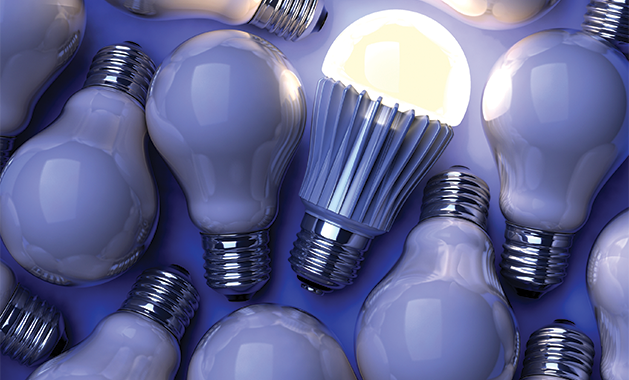
With winter around the corner and days growing shorter, new lighting technologies can transform your surroundings—in real life and online. The lighting gurus from Energy Management Collaborative (EMC) in Plymouth have advice on getting started with better LED bulbs and the cutting edge of internet technologies.
LEDs can be found in many everyday gadgets, from electronics to cars, and now in standard lightbulbs for offices, businesses and homes. These smarter bulbs help to save utility costs and energy, with longer lifespans than traditional incandescents and better light quality than fluorescents, says EMC engineer Tony Johnson.
EMC works with industrial, retail and commercial corporations, as well as government organizations, to bring lighting solutions through LEDs. On top of cutting down on expenses and saving energy, EMC and other companies predict these lightbulbs will one day be our connection to the internet.
This system of the future is called Light Fidelity or Li-Fi. Similar to Wi-Fi, it communicates information through visible spectrums of light as opposed to Wi-Fi’s use of radio waves, says EMC CEO Jerry Johnson.
“It’s using a different area of the communication spectrum. It’s a higher frequency, so a lot higher speed, theoretically 1,000 times faster. It uses lights which are almost everywhere. If they’re there, why not use them?” he says.
Anywhere in sight of a Li-Fi powered LED could be a link to fuel phones, tablets, laptops and more with connectivity. The nature of the light-powered system would allow for a more consistent, reliable internet connection, eliminating dead zones and weak coverage often found with Wi-Fi, Jerry Johnson says. The new system also offers greater security, as the light waves cannot pass through wall.
Although Li-Fi shows a lot of promise, the pair agree the technology is still some years away from general accessibility.
“It’s in its extreme infancy, still mostly lab-based,” says Tony Johnson. “Eventually it’ll find its way into the market, maybe five years away from the first wave of really commercially available product.”
In the meantime, he recommends incorporating LEDs into homes and office spaces to experience the benefits of the better bulbs.
“Number one, the energy you save is definitely real and you can see it in your bills. The prices [of bulbs] have dropped to a level that it makes it really smart to change over as much as you can to LED,” Jerry Johnson says. “The other thing is the light is actually better. It throws it different, illuminates more areas. The quality in terms of color and how you use it is superior to incandescent.”
Tony Johnson began switching over in his home in 2011 when LEDs ranged from $30–$40 a bulb. Today, standard bulbs run $5-$10 and are available in a variety of styles and colors compatible with virtually any fixture or atmosphere.
In his 1940s home, Tony Johnson was able to find standard LEDs for several different types of sockets, without retrofitting or renovating. As for those first bulbs, they are still in use and performing well after six years of use.
“Make sure you’re buying the right ones. For anyone not used to looking at light bulbs, it can be a bit overwhelming. You can get your opportunity to get your hands on the wrong thing,” he says.
Jerry Johnson recommends going in stages. Pick a frequently used space and see the transformation LEDs can make in the room.
Bring old bulbs with you to the store and ask for help if you need it, he says. With a little bit of homework and handy work, LEDs can reinvent your space for years to come.
To learn more about LEDs and Energy Management Collaborative, visit them online at the website here.









